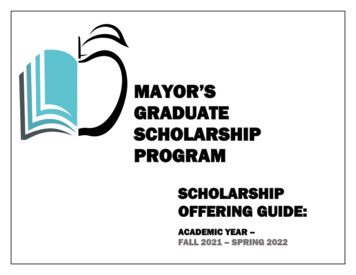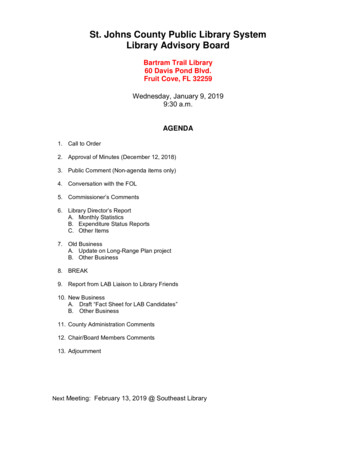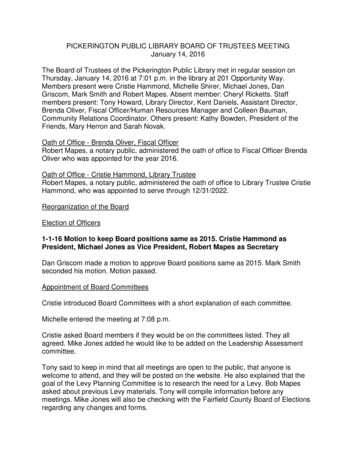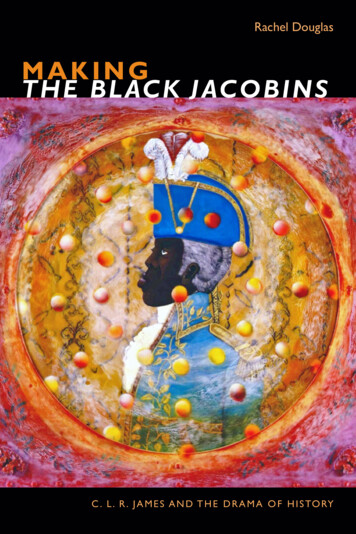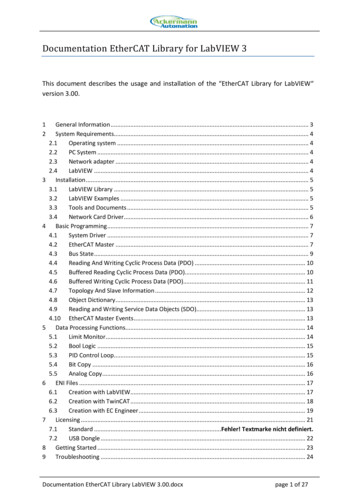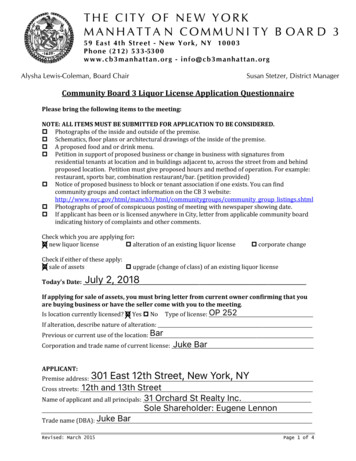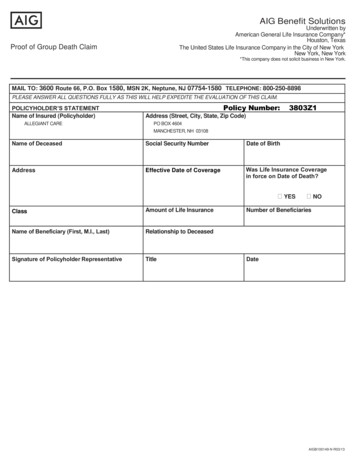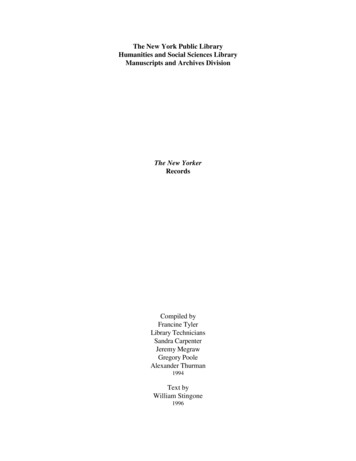
Transcription
The New York Public LibraryHumanities and Social Sciences LibraryManuscripts and Archives DivisionThe New YorkerRecordsCompiled byFrancine TylerLibrary TechniciansSandra CarpenterJeremy MegrawGregory PooleAlexander Thurman1994Text byWilliam Stingone1996
SUMMARYMain Entry: The New Yorker RecordsTitle: Records ca. 1924-1984Size: 875.8 linear feetAccess: Two boxes, # 1302-1303, labeled "Eccentrics, 1969-1975," are restricted until2050; otherwise access is unrestricted.Source: Gift of The New Yorker, 1991.Historical Statement: The New Yorker magazine began publication on February 21, 1925.Description: Included are general and editorial correspondence; editorial memoranda;holograph and edited non-fiction, fiction and verse manuscripts; critical notes on writingsand ideas for articles; files, called "Copy and Source," containing materials to be publishedin each week's issue; reprint and permissions requests; letters to the editor; press releasesand newsclippings; original art work called "spots" and tearsheets of thousands of cartoons;photographs, posters, and sound recordings.Copyright information: See Notice of Conditions and Restrictions at end of inventory.Related resource: For a list and description of the John Cheever materials in The NewYorker Records, see Botha, Francis J., “The John Cheever Papers at the New York PublicLibrary’s Manuscripts and Archives Division,” Resources for American Literary Study,Vol. 27, No.1 and No. 2, 2001. [Online access via Project Muse available for NYPL onsite users].1
HISTORICAL NOTEHarold Ross and the Founding of The New YorkerHarold W. Ross was born in 1892 in Aspen, Colorado to George Ross, an Irish immigrant, andIda Ross, a school teacher from Kansas. Ross dropped out of high school after his sophomoreyear. His first job as a newspaper man was in Salt Lake City, at The Tribune. He became atramp newspaperman, working at 23 newspapers in 6 years. In 1917 he enlisted in the Army.During World War I he was a staff member and then editor of Stars & Stripes.On returning from the war Ross launched the Home Sector, a continuation of the Stars & Stripespublished for returning veterans. In 1920 Ross married Jane Grant whom he had met in Franceduring the war through a friend and colleague at the paper, Alexander Woollcott. By the time ofhis marriage Ross had become editor of American Legion Weekly (which had absorbed HomeSector). It was soon apparent that Ross was not satisfied working for a house organ.For some time the couple lived on Grant’s salary from The New York Times and saved Ross’ssalary towards his dream publication. He believed there was a gap in the magazine industry, thatthere was room for a sophisticated, funny, urbane, upscale weekly. He found contemporarymagazines (i.e. Judge, Life, Saturday Evening Post) either sophomoric, or middlebrow.Furthermore these national magazines were not suited to upscale advertising because they had toappeal to readers spread throughout the country and of all levels of sophistication and income.For Ross, the number of people reading his magazine would not be as important as who wasreading it. Ross’s audience would be educated, cosmopolitan New Yorkers, who spent money infine restaurants and stores the kind of audience advertisers would pay to target.In 1924 Ross was still shopping his dummy of what would become The New Yorker around whenhe accepted the position as editor of Judge. While this publication embodied the stale humor forMid-Americans to which Ross’s magazine would reply, Ross hoped to experiment with some ofhis editorial ideas in its pages. Ross left Judge after 5 months.Later the same year, Ross succeeded in selling his idea to Raoul Fleischmann, the yeast-fortuneheir; Fleischmann supplied an initial investment of 25,000 that was matched by Ross and Grant.Fleischmann ended up investing another 700,000 in the magazine over the next three years. (Atone point during the first year, Ross and Fleischmann actually decided to cease publication butchanged their minds only days later). Their partnership was often rocky: Ross always suspectedhe was being worked to death for Fleischmann’s economic benefit. Nevertheless, Fleischmannspent the rest of his life, until 1969, as vice president, president, chairman, and publisher of TheNew Yorker; Ross spent the rest of his as its editor. While it exacerbated his ulcers, Ross’ssuspicion of his publisher helped to establish the unique editorial autonomy at the magazine, anautonomy Fleischmann, and his son Peter, would respect even after Ross’s death.
NEW YORKER RECORDS GUIDENOTESEarly YearsThe first issue of the New Yorker appeared on February 17, 1925. The first few issues wereeditorially and financially unsuccessful, and Ross was forced to include a lot of poor material tofill unsold advertising space. These lean months led to Ross’s (and later William Shawn’s)infamous habit of stockpiling manuscripts against a day when there might be no good copy topublish. For several years, departments were constantly switched in and out of the magazineuntil a proper mix was established; yet, even as the magazine’s format gelled, the execution stillsuffered. Only art cartoons, covers, illustrations worked from the beginning, thanks to theinfluence of the art director, Rea Irvin. Irvin not only created the layout, typeface, andsymbol Eustace Tilley of the magazine, but taught Ross about art.After a large promotional push orchestrated by John Hanrahan, a man disliked by Ross becausehe was brought in by the panicked Fleischmann, Fall 1925’s ad pages were up. By the spring of1926 The New Yorker was making money and by the next year it was in the black. Of course, itwas not only Hanrahan’s promotion which helped the magazine onto its successful path. Themagazine’s content had improved considerably with the addition of several pivotal staff memberswho helped Ross define his magazine’s voice much as Irvin had helped establish its look.Katharine Angell (later Katharine S. White) was hired in the summer of 1925 as a part-timereader of manuscripts; almost immediately she became a full-time worker and a principal factorin the magazine’s maturation. Ross used White as the final word on “sophistication,” on tasteand style, and she was involved with every aspect of the magazine. The two fed on each other’senergy. In 1927 E.B. White, James Thurber, and Wolcott Gibbs all came aboard. Besidesfriendship and support, these writers provided the clear, precise, and imaginative prose abouturbane topics for which the New Yorker became famous.In 1929, hot on the heels of the stock market crash, the magazine announced it would appear intwo editions: one for New York City (to appeal to advertisers targeting its inhabitants only) andone for the rest of the country.1 Somehow, The New Yorker was able to sustain its successthroughout the thirties. It remained aloof from the Depression, maintaining its ironic, whimsical,and casual tone. According to William Shawn, at that time the staff was “actually proud of beingapolitical and socially detached.” The magazine had yet to establish its reputation for analyticaljournalism: it remained primarily a humor magazine.Even as the magazine flourished and the staff solidified, Ross’s frenetic panic-riddenmanagement style lingered. It was difficult for him to delegate authority: his vision andinvestment were at stake. Ross knew he could not continue his attempts to do it all (withoutdriving himself and his staff crazy), yet, rather than dividing responsibilities sensibly, Ross1In April of 1960, its national audience grown sizably, the magazine dropped its city edition.ii
NEW YORKER RECORDS GUIDENOTESsearched for the man or woman who could do it all. For years he sought someone who couldhead the editorial department, keep all departments on schedule, and get the magazine out eachweek. He called this savior a “managing editor’, but to everyone else he was known as “Ross’sJesus.” There were as many as 30 of these figures, all failures.Finally in the 1936, with Ik Shuman floundering much as his predecessors had, the Jesus paradeended. Ross offered St. Clair McKelway, who was then a reporter and editor of non-fiction (orFact) pieces, this “managing editor” position. McKelway accepted on the condition thatFact journalism editorship be separated from Fiction fiction, verse, art editorship. Notonly would this division create more manageable parts, but would free fiction editors, such asWolcott Gibbs and Katharine White, from the responsibility of editing journalism. Rossaccepted this deal: McKelway became editor of Fact, taking Sanderson Vanderbilt and WilliamShawn as his assistants; White became Fiction editor; and Shuman was left with the remainingadministrative duties.In McKelway’s three year tenure as editor (1936-1939) he developed a group of young writerswho would establish the magazine’s standards of literary journalism. This group of writersincluded Joseph Mitchell, A.J. Liebling, Brendan Gill, E.J. Kahn Jr., Emily Kahn, and PhilipHamburger.Fiction, on the other hand, was slower to develop. Ross was less predisposed to fiction than hissuccessor Shawn, and, especially in the beginning, the magazine’s low pay made it impossible tocompete for the works of Hemingway or Fitzgerald. Ross could not get the big names, but felthe could still find good writing. He made his fiction editors Katharine White, then GusLobrano keep lists of promising young writers and stay in touch with them. He also insistedthat his editors tend to these writers with the utmost care and attention by providing promptreadings, responses, and payment. Editors became the writers’ friends and support.This treatment helped compensate for the magazine’s famous low pay. (Unlike Fact writers, whohad the luxury of accumulating debt from the magazine’s drawing accounts, fiction writers livedfrom sale to sale.) It was one reason writers continued to publish their work in The New Yorkereven after it had helped them achieve renown.The War YearsMcKelway resigned in 1939 and returned to writing and reporting exclusively. William Shawnbecame editor of Fact. One of his first acts as editor was to convince Ross that the magazineshould seriously commit to covering the coming war, in contrast to its near obliviousness to theDepression.iii
NEW YORKER RECORDS GUIDENOTESReports in words and pictures were dispatched from all over the world. They were literaryfirst-hand accounts, not full of received information, about interesting people, places, and things.The dispatches from overseas written by A. J. Liebling, E. J. Kahn, Philip Hamburger, andMollie Panter-Downes among others gave the magazine a new depth, scope, and seriousnessthat continued after the war’s end. The most famous, and perhaps most important, of thesearticles was John Hersey’s “Hiroshima,” which appeared as an entire issue of the magazine onAugust 31, 1946. It was Shawn who urged Ross to give Hersey’s article its own issue. Ross latercalled its publication the most satisfying thing he had done in his life.As the magazine flourished editorially, business became better than ever. In 1944 total revenuesexceeded 4 million for the first time. Because of wartime excess-profit taxes and papershortages the magazine needed to find ways to limit circulation actually ceasing to take newsubscriptions for a period during 1943. That same year, Jane Grant, by then Ross’s ex-wife,suggested the magazine publish a smaller sized edition for distribution to the armed forces. IkShuman convinced Fleischmann and Ross that it would help solve some of their paper woes, andGrant used her vast connections to circumvent governmental red tape.The “pony” edition appeared in September 1943 as a monthly with no ads and a circulation of20,000; by the following March it was a weekly, and by the end of 1944 its circulation exceeded150,000. The edition was a success in every way. Most importantly, it introduced a whole newgeneration of readers to the magazine. After the war, circulation of the regular magazineincreased dramatically, and for the first time The New Yorker became more of a nationalpublication than a comic weekly for “sophisticated” East-Coasters. In 1947 the magazine’scirculation leapfrogged to 320,000, many of the readers living outside New York.2 Themagazine was a national cultural heavyweight.Despite the success, there were problems at the magazine. The loss of manpower in the officemeant that for much of the war years Shawn and Ross were practically handling the entire Factdepartment themselves. In the spring of 1943 the Whites came back to New York and themagazine. (In 1938 the Whites had left for Maine, leaving two giant holes at the magazine anddepriving Ross of two of his best friends.) Their return provided some relief for a beleagueredRoss. Still, racked by the stress of the short-staffed war years and personal financial problemsRoss felt he had to leave the magazine, something he had threatened several times previouslyduring disputes with Fleischmann. Over the years Ross had grown increasingly hostile towardsFleischmann and his “group.” Ross suspected that while all his hard work had helped make this“group” rich, which it did, Ross’s only profits were ulcers and alimony payments. By November1945, however, Ross signed a new contract, which included an option to quit with three monthsnotice, and a consultant job for Jane Grant. The latter stipulation was added to absolve Ross ofany financial obligations to his ex-wife.2Circulation had already increased from 170,000 in 1943 to 260,000 in 1945.iv
NEW YORKER RECORDS GUIDENOTESRoss’s new contract also required that Ross groom a successor. The three front-runners wereShawn, Gus Lobrano (Fiction editor), and James Geraghty (Art Director). When Ross died onDecember 6, 1951, during an operation for lung cancer, the successor was still unknown.The SuccessionOn January 21, 1952 a memo from Fleischmann was posted in the editorial offices. It announcedthat William Shawn had accepted the position of editor effective immediately. Shawn hadbegun his career at the New Yorker as a “Talk of the Town” reporter in 1933, in 1936 he wasassociate editor to McKelway, and in 1939, Shawn became managing editor of Fact and Ross’sright hand.Brendan Gill writes: “Under Shawn, the magazine broadened its range, lifted its gaze, deepenedits insights.” Many consider Shawn responsible for bringing social consciousness to Ross’screed of facts, accuracy, and clarity and thus transforming a cosmopolitan humor magazine intothe most important one in the nation if not the world. However, it is apparent that thistransformation was well under way by the time World War II definitively established themagazine as a source of serious journalism. Shawn’s influence is obvious, but it was the state ofthe world depression, fascism, war which made Ross’s decision to steer his magazine in amore serious direction ineluctable.Shawn happened to be the perfect man to help Ross make the magazine more intellectuallychallenging, politically engaged, and journalistically audacious, and then continue these trends aseditor. Under Shawn’s editorship the magazine would to cover the entire world and consistentlyraise the standards for literary and investigative journalism. Shawn’s New Yorker became themost successful magazine in the country and one of the most important in the world.3The Editing ProcessOver the Ross and Shawn years the magazine was edited and put together in similar ways.Both editors read every word of the each issue before it was published. (Some staff claim Shawnread most pieces two or three times.) Ross’s editorial style was hands on, detailed oriented, andsome say maddening. He produced query sheets and memos of incredible detail and length.Shawn did not share Ross’s penchant for memo writing. Instead he conducted most of hisbusiness with writers, staff, and Ross in person. He was known for his almost reverentialtreatment of writers and an editing style which was firm while never condescending and hecultivated strong bonds with those he worked with closely. (By 1970 Shawn had already had 50books dedicated to him.) While the styles of the editors differed (out of the office as well as in)their goal was the same: accuracy and clarity.3By 1975 80% of the magazine’s readership resided outside New York, the circulation was 492,000, and 693 bookswere produced from its art and writing.v
NEW YORKER RECORDS GUIDENOTESNeither editor had complete control of what advertisements went into the magazine, but theiropinions of certain ads or products carried great weight. Eventually, strict rules werepromulgated in the ad department regulating the copy of ads and the type of products allowed inthe magazine. Both editors believed in a strict separation between the business and editorialsides of the magazine. (Shawn went as far as banning members of the advertising staff from the18th floor of 25 West Forty-third Street, the editorial offices.) Shawn admitted, however, that hewas able to meddle in advertising affairs more than he would have been able to at any otherpublication.Ross’s struggles with Fleischmann left Shawn with an environment in which he enjoyed greatfreedoms. He set his own budget and never needed to provide an accounting of how each year’smoney was spent. This allowed Shawn to give his writers exceptional leeway to develop theirown ideas (articles were never assigned) into articles, while they were supported by drawingaccounts, far more generous and therefore dangerous, than those of the Ross days. The lack offiscal accountability also allowed Shawn to keep everyone’s salary or payments a secret, whichwas a New Yorker tradition. (Ross’s systems for paying writers were notoriously Byzantine: noone really understood their own pay, and so, as Ross hoped, neither could anyone figure out whatthe other writers or staff earned. Under Shawn, methods of payment and salary became no lessmystifying.)In the case of both staff and freelance writers, Fact pieces had to be approved by the Fact editorand/or Ross or later Shawn. Topics, or persons in the case of Profiles, were “reserved” bywriters, or for writers by editors. After the writer wrote the first draft he or she collaborated withan editor (by letter or more often in person) in line-by-line revision. For Fiction no reservationswere made; stories were considered only on submission; they were read by several editors andthen a vote on acceptance was taken.Proofs of edited stories went to the editor, copy editor, and fact-checking department. The editorreviewed all the corrections made on the proofs with the author by phone, mail, or in person.New Yorker editors were famous for “suggesting” changes; while editors were always tactful,never adversarial, writers were aware that refusing certain suggestions might mean his or herstory would not appear in the magazine. After the last changes were made the story was proofedagain and put into the manuscript bank where it is ready to run at any time.44Each issue had a designation, “A” being the next issue, “B” the one after that, and so on (with issue “X” being theissue just published). Art and copy were assigned letters as they were taken from the banks and slated forpublication.vi
NEW YORKER RECORDS GUIDENOTESArt especially cartoons were a collaborative affair. “Idea men” were employed by themagazine to come up with cartoon concepts and captions. Some of these idea men wouldexecute their own first drawings. Ross, Shawn, or other editors would assign an idea to the artistthey felt most suited to its execution. On Tuesday afternoons, Ross, then Shawn, would presideover the art meetings in which drawings were critiqued and changes suggested.Tension and TurmoilAfter reaching its peak in the late 1960s, the magazine’s ad space continually decreased throughthe 1980s. William Shawn believed that the staff edited the magazine not for advertisers, or evenreaders, but for itself; he did not believe in editing down for a certain audience, but in putting outthe best possible magazine. Outside the magazine Shawn’s editorial integrity and talents wereadmired and acknowledged almost universally. Yet, as revenues continued to decline, hisprincipled stances sometimes exasperated internal tensions.In the early 1970’s, Shawn began to feel the need to groom a successor. His first candidate wasBob Bingham, but by 1975, three years after he had made Bingham “executive editor,” Shawnknew Bingham could not be Editor. His next choice was Jonathan Schell, a young man who hadwritten several articles and Comment (as the “Notes and Comments” department was known)pieces on Vietnam that some readers and staff found overly polemical, ideological, and political.Senior editorial staff reacted against Schell as Shawn’s successor; soon Shawn dropped the ideaof grooming Schell. In 1978, in an attempt to calm the waters stirred by the Schell affair, Shawncirculated a memo stating that he was staying on. Peter Fleischmann, who had succeeded hisfather as chairman of The New Yorker Inc. in 1969, was still not satisfied. He was growing tiredof the persistence of the succession question and made no secret of his frustration with Shawn’sindecision. Shawn responded to this lack of confidence by resigning, with the stipulation that hewould remain for two years or until a new editor was found and sufficiently prepared.Shawn did not leave in two years, and the drama played itself out inconclusively until 1985 whenS. I. Newhouse Jr.’s Advance Publications, Inc. bought The New Yorker. Advance Publicationsalso owned the Condé Nast magazine group and Random House. There was considerable unrestspreading throughout the editorial floors; the staff feared for its editorial autonomy. WhileAdvance Publications attempted to assuage their fears with a statement of commitment to Shawnand his magazine, significant changes were imminent.vii
NEW YORKER RECORDS GUIDENOTESThe End of an EraThe changes began in 1986. Peter Fleischmann resigned due to health reasons, although manysuspected his stepping down was precipitated by the takeover. Then on February 13, 1987,William Shawn was fired and Robert Gottlieb was named Editor of the magazine. The magazinewas seen as needing a transfusion of new blood after 25 years of William Shawn’s editorship: inaddition to the steady decline in revenues, the magazine did not seem to be cultivating newtalent. While the staff agreed in part with this view, it was angered by the manner of Shawn’sdismissal and questioned the ability of Gottlieb, an outsider with no magazine experience, to fillShawn’s formidable shoes.Gottlieb’s tenure was relatively uneventful and moderately successful. In June of 1992, however,he resigned after disputes with S.I. Newhouse over the direction the magazine should take.Gottlieb thought that the few small changes he had made at the magazine were enough and sawno need for further evolvement. Tina Brown, who had been editor at Vanity Fair, another ofNewhouse’s Condé Nast publications, was named Editor.viii
NEW YORKER RECORDS GUIDENOTESSCOPE AND CONTENT NOTEThe New Yorker Records (ca. 1924-1984) consist of the correspondence, interoffice memoranda,edited and corrected manuscripts and typescripts, drawings, posters, statistical reports, lists ofstory and art ideas and assignments, photographs, and sound recordings generated during thefoundation and day-to-day operations of the magazine’s editorial departments. The recordsdocument the decisions made in producing each issue of the magazine, as well as the careers ofits staff and many of the important twentieth-century writers and artists who regularly contributedto the New Yorker.The general files of Harold Ross (1917, 1924-1957), the magazine’s founder and editor until1951, contain mostly memoranda and correspondence which document Ross’s role in shapingeach issue of the magazine and its overall identity. His personal papers provide insight intoRoss’s life and the cultural milieu in which the New Yorker was born and thrived. The collectioncontains only a few of William Shawn’s files, but his role as editor is evident throughout thecollection.Interoffice memoranda are represented in almost every part of the collection and include criticalcommentary on particular issues or pieces in the magazine, editor’s queries, reports on authors’and artists’ contractual status, approval or disapproval of advertisers or particular ads, editors’story suggestions, writers’ story reservations, and discussions of legal and administrative issues.The memos reveal the meticulous detail with which every aspect of the magazine was addressed.Editorial correspondence (1928-1980) is an extensive archive of correspondence between NewYorker editors and writers, artists, agents, publishers, organizations, and other New Yorkereditors and staff, and so documents the editors’ roles in shaping the content from journalisticpieces and fiction, to art and advertising of each issue. The exchanges between editors andwriters document the crafting of particular pieces; because many of these writers’ stories andarticles first appeared in the New Yorker, the magazine’s editorial process greatly informed thefinal versions of their work. The correspondence of writers associated with the New Yorkertraces their history with the magazine and its editors, as well as the trajectories of their careers.Manuscripts in the collection are of two types. “Run & Killed” manuscripts are often editeddrafts of mostly non-fiction pieces. Writer’s works were passed among several editors forcomments, and if approved, manuscripts were circulated among editors for suggestions and forrevisions. These comment memos often accompany the manuscripts in the “Run & Killed”series. “Copy & Source” files contain typescripts of all the copy in each issue of the magazinefrom 1951-1981 (see Provenance Note). Because of the rigorous editing and fact-checkingprocesses at the New Yorker, most manuscripts/typescripts are heavily revised and corrected andare often accompanied by memos, queries, or correspondence between author and editor.ix
NEW YORKER RECORDS GUIDENOTESIn Editorial Business files (1926-1984) letters to the editor (never published in the magazine until1992), the staff’s answers to these letters, and reprints and permissions requests illustrate theimpact and popularity of the magazine’s articles, stories, and cartoons; log books, lists, and filesof ideas for articles and art document methods by which the magazine generated editorial contentand how writers chose assignments. Other administrative records include accounts of contributorpayments and staff salaries, memoranda concerning contractual status of artists and writers, andcorrespondence related to legal matters. The legal and financial files contain material relating tosuits and counter-suits, contracts with authors and artists, and additional information regardingstaff and contributor payments.Artwork is spread throughout the collection mostly in the form of tearsheets. The “Non-TextualMaterials” series consists of original drawings and photographs removed from other parts of thecollection; original spot drawings; tearsheets of published cartoons and accompanying editors’comments, notes, and memoranda; and Harold Ross’s recorded dictation. There are someoriginal drawings in “Magazine Make-Up: Copy and Source.”PROVENANCE NOTEThe New Yorker Records were donated to the New York Public Library by The New YorkerMagazine Inc. in March 1991. Before it could be transferred to the Library, approximately 144linear feet of material disappeared during The New Yorker’s move to new offices in February1991. The missing files included the “Copy & Source” files (discrete weekly files of setting copyof each issue) covering the years 1929-1950 (88 linear feet); eight linear feet of “Killed,” orrejected, non-fiction manuscripts (1941-46, 1950, 1954-1955); records of payments, advances,and royalties to authors and artists (1942-1949, 1979, 34 linear feet); directors’ minutes andannual reports for 1948-1949 (12 linear feet); and correspondence and memoranda relating toadvertisers, advertising policy, and results of advertising (1973-1974, 4 linear feet).x
NEW YORKER RECORDS GUIDENOTESSERIES DESCRIPTIONSSERIES I: EDITOR1924-198456 linear feet Boxes 1-129This series contains the files of the first two editors-in-chief (titled, simply, “Editors”) of the NewYorker. Harold Ross’s personal and professional papers make up the bulk of the series. Thecollection contains only a few of William Shawn’s files but his role as editor is evidentthroughout the collection.The Editor series is arranged in three subseries:1.1 Harold Ross / General Files1.2 Harold Ross / Personal / Financial Records1.3 William Shawn1.1 HAROLD ROSS / GENERAL FILES1917, 1924-1957 51.5 linear feetBoxes 1-118Ross’s general files (Boxes 1-69) are composed mainly of letters, telegrams, and interofficememos. This correspondence documents Ross’s daily work as founder and editor of the NewYorker. Other materials in this series include lists of ideas, possible writers, agents, and articleassignments; advertising records; business and legal documents; scattered manuscripts; posters;photographs; periodical tear sheets; and clippings.The records dating from 1924 through 1927 are thin but provide detailed insight into themagazine’s beginnings: they document Ross’s earliest editorial and business decisions. Ofspecial note is the 1924 “Prospectus,” Ross’s first and only detailed articulation of themagazine’s goal and mission. Interoffice memos constantly passed between Ross, RaoulFleischmann (the magazine’s original financial backer), editors, and other staff. Ross did most ofhis text-editing by letter, memo, or notes which sometimes ran to pages of queries andsuggestions. These memos, along with Ross’s correspondence, reveal much about hispersonality, as well as his relationships with staff, contributor
Main Entry: The New Yorker Records Title: Records ca. 1924-1984 Size: 875.8 linear feet Access: Two boxes, # 1302-1303, labeled "Eccentrics, 1969-1975," are restricted until 2050; otherwise access is unrestricted. Source: Gift of The New Yorker, 1991. Historical Statement: The Ne


